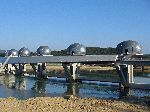Ibike Korea People-to-People Program
 Photo essay:
Yangsu to Yeoju
Photo essay:
Yangsu to Yeoju
Points of Interest: Rails-to-Trails facility, small towns, art, dams
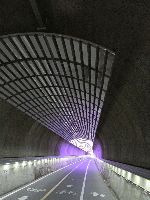
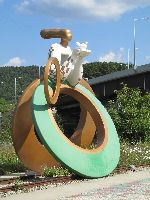
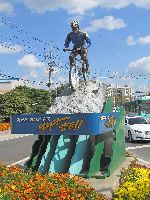
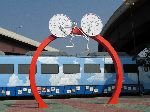
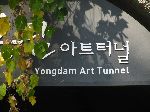
The first section is on the old rail road bed and uses the old rail road tunnels. Several of the tunnels have been enhanced with art installations that feature arrays of light panels on the ceiling that flash and sequence in a variety of patterns. (Note: They were operational during a tour in 2014, but not in 2015) There is also a variety of art along the trail. Much of it is bicycle themed.
South of Yangpyeong the route follows the shoreline, weaves
through villages and pass a variety of creative amusements.
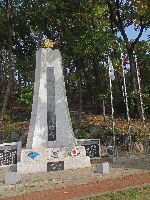
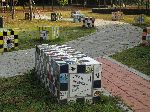 and people, by showing them a good example of defending against any threat to
their country's security and the world's peace and freedom."
and people, by showing them a good example of defending against any threat to
their country's security and the world's peace and freedom."In the adjacent park is a playful installation from 2010 call "Art Bench / Art Cube."
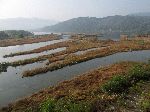
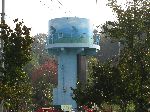 The
islands (left) are where the Heugcheon (Black River) flows into the Hangang
(river), that flows across the top of the photo, south of Yangpyeong.
The
islands (left) are where the Heugcheon (Black River) flows into the Hangang
(river), that flows across the top of the photo, south of Yangpyeong.Another kilometer south, in Angdeok-gil, the water tower has been decorated with a mural of bicyclists. The route is away from the river and on village roads at this point. At least on the weekend the residents probably see far more bicycle traffic than motor vehicles. Hopefully they find it a pleasant addition to rural life.
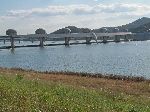
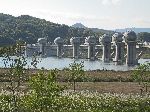 Of
Ipo-bo
(wier), the National Tourism website says, "Seeking to reflect the harmony
of man and nature through water, the weir was built in the shape of an egret
rising up into the sky."
Of
Ipo-bo
(wier), the National Tourism website says, "Seeking to reflect the harmony
of man and nature through water, the weir was built in the shape of an egret
rising up into the sky."
Ipo-bo (weir) was new in 2011, a part of the Four Rivers Project. The project includes the Han River (Korea), Nakdong River, Geum River and Yeongsan River. The primary goal of the "restoration" project is to provide or improve water security, flood control and the ecosystem's vitality. The primary activities was building dams and levies. (If restoration conjures up images of a natural, free-flowing river this was the antithesis, but we digress.)
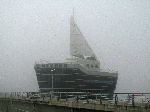 The
observation center at Ipo-bo looks like a ship -- even more so
and a bit mysterious when shrouded
in the morning mist.
The
observation center at Ipo-bo looks like a ship -- even more so
and a bit mysterious when shrouded
in the morning mist.
The Four Rivers Project was first announced as part of the “Green New Deal” policy launched in January 2009. Most of the work is suppose to be completed by 2012. For the big earth reshaping projects; dam construction, river bottom shoveling and dredging, channelization of the river banks, it is debatable whether the initiative is more destructive or constructive for the environment.
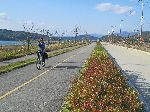
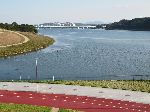 But the
impact of the ribbon of environmental-friendly upland non-motorized trail facility
is not in doubt. For walkers, roller-bladers, and the previously almost
not existent long distance bicyclists, it is a game changer. The new trail
infrastructure has opened up beautiful recreational opportunities from one end
of the country to the other.
But the
impact of the ribbon of environmental-friendly upland non-motorized trail facility
is not in doubt. For walkers, roller-bladers, and the previously almost
not existent long distance bicyclists, it is a game changer. The new trail
infrastructure has opened up beautiful recreational opportunities from one end
of the country to the other.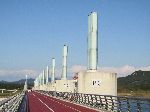
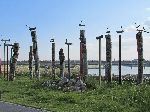 Yeoju-bo
(weir) is another of the Four Rivers Projects.
Yeoju-bo
(weir) is another of the Four Rivers Projects.
"So-tae," wooden birds on poles. Traditionally these marked the boundaries of a village and were for good luck. Contemporarily the are used more as decorative art, as they are here.
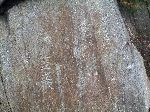
 This
rock (left), a couple kilometers north of Yeoju, is in Neungseo-myeon,
Wangdae-ri. It marks Ipahm, one of the "Eight Most Picturesque
Scenes of Yeoju." The first section of the engraving says Ipahm was marked on Chinese maps (16th C
by the Ming Dynasty) and Korean maps (18th C, during the Chosun Dynasty). A
local maps printed in 1872, of a larger scale, marked this rock as ‘笠巖’
(a conical hat). The next section of text refers to some local officials and
notable citizens at the time. The last sections describes the team that
supervised the engraving in the late autumn of 1870.
This
rock (left), a couple kilometers north of Yeoju, is in Neungseo-myeon,
Wangdae-ri. It marks Ipahm, one of the "Eight Most Picturesque
Scenes of Yeoju." The first section of the engraving says Ipahm was marked on Chinese maps (16th C
by the Ming Dynasty) and Korean maps (18th C, during the Chosun Dynasty). A
local maps printed in 1872, of a larger scale, marked this rock as ‘笠巖’
(a conical hat). The next section of text refers to some local officials and
notable citizens at the time. The last sections describes the team that
supervised the engraving in the late autumn of 1870.Just as you reach Yeoju there is a turn to the very interesting Royal Tombs at Yeongneung (click to visit).
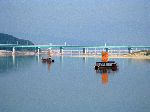
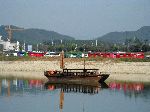
Now-a-days about the only boats on the river are replicas of the old boats that are now equipped with motors. They are used for the new economy of "cultural tourism". Yeoju is one of the locations you take a river curise. (Given the population and the amount of water, personal speed boats and jet skis are relatively rare.)
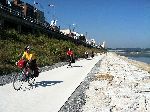
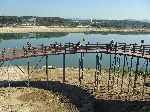 One
of the first sections of the National Bikeway was built in Yeoju in 2011. It
hugs the south bank of the river through town. In the middle of Yeoju the
riverside trail ends and there is a pig tail viaduct which brings users to
street level and into town. The National Bikeway system continues south on
sidewalks and there is a bridge across the river which gives access to rural
roads that can also be used to head south and east.
One
of the first sections of the National Bikeway was built in Yeoju in 2011. It
hugs the south bank of the river through town. In the middle of Yeoju the
riverside trail ends and there is a pig tail viaduct which brings users to
street level and into town. The National Bikeway system continues south on
sidewalks and there is a bridge across the river which gives access to rural
roads that can also be used to head south and east.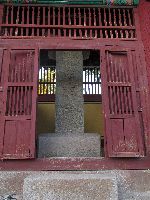
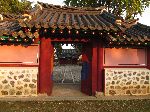
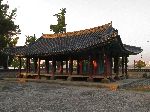
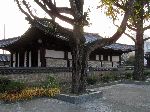 Located
near the river, in the middle of old Yeoju, is Daerosa. It was built in
1785 on the instructions of King Jeongjo, to honors Song Siyeol (1607-89). Song
was a leading Confucian scholar and meritorious government official of the
mid-Joseon period (1392-1910). He is enshrined here. The King wrote the
signboard himself. The stele (left) records the history of Daerosa, On the back
are inscribed the epitaph written by King Jeongjo. In 1873, King Gojong renamed
the shrine Ganghansa, but currently is again Daerosa.
Located
near the river, in the middle of old Yeoju, is Daerosa. It was built in
1785 on the instructions of King Jeongjo, to honors Song Siyeol (1607-89). Song
was a leading Confucian scholar and meritorious government official of the
mid-Joseon period (1392-1910). He is enshrined here. The King wrote the
signboard himself. The stele (left) records the history of Daerosa, On the back
are inscribed the epitaph written by King Jeongjo. In 1873, King Gojong renamed
the shrine Ganghansa, but currently is again Daerosa.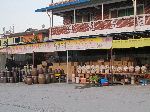
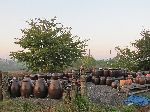
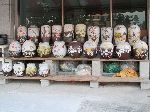
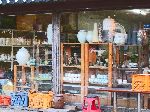
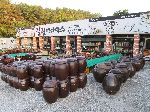
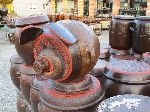
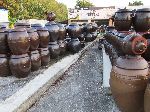 Yeoju
claims to be the pottery capital of Korea. There are no shortage of towns
that produce a lot of pottery in Korea, but in Yeoju the shops seem to be bigger
and they stretch further down the road, so we will appreciate the photo
opportunities that it creates and let the locals bask in the glory of the
accolade.
Yeoju
claims to be the pottery capital of Korea. There are no shortage of towns
that produce a lot of pottery in Korea, but in Yeoju the shops seem to be bigger
and they stretch further down the road, so we will appreciate the photo
opportunities that it creates and let the locals bask in the glory of the
accolade.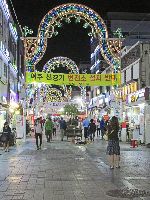
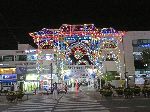
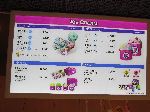 Yeoju's shopping district is simple and relatively
non-distinctive by day, but at
night it is bathed in light and sparkles, and fills with people -- many of the
young, but also young families.
Yeoju's shopping district is simple and relatively
non-distinctive by day, but at
night it is bathed in light and sparkles, and fills with people -- many of the
young, but also young families.Among the stores that is open late for those wandering in the evenings fresher air is Baskin and Robins.
Of some distinction, Yeoju must have one of the highest concentration of Gimbap restaurants in the country. Within four blocks there are at least four of these fast food establishments..
 Please
contact us if you would like to be added to
Ibike's mailing list or have questions, comments, corrections or criticism. (Also, please let us know how you learned about us and
found this site.) Privacy policy.
Please
contact us if you would like to be added to
Ibike's mailing list or have questions, comments, corrections or criticism. (Also, please let us know how you learned about us and
found this site.) Privacy policy.
![]() IBF Homepage
IBF Homepage ![]() Ibike Programs
Ibike Programs
![]() Ibike Schedule
Ibike Schedule
![]() Search
Search
